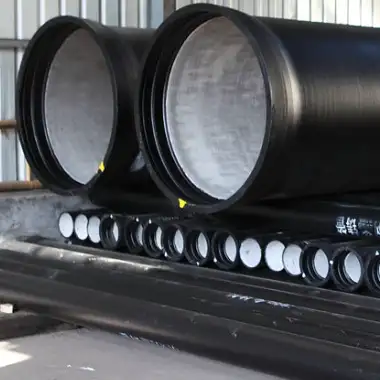ASTM A536 Grade 65-45-12 is a ductile iron alloy known for its balanced strength and ductility, with a tensile strength of 65 ksi (450 MPa), yield strength of 45 ksi (310 MPa), and 12% elongation. Heat treatment of this grade enhances its mechanical properties, improving machinability, toughness, and stress relief. Common heat treatment methods include annealing, normalizing, and quenching & tempering, depending on the desired performance. This guide explores the best heat treatment processes for ASTM A536 65-45-12 ductile iron, its applications, and how it optimizes material performance in automotive, construction, and heavy machinery components.

1. Introduction to ASTM A536 Grade 65-45-12
ASTM A536 Grade 65-45-12 is a specification for ductile iron castings, also known as spheroidal graphite (SG) iron. This grade is characterized by its combination of high tensile strength and moderate elongation, making it suitable for applications where strength is paramount, but some degree of ductility is still required.
The designation “65-45-12” refers to the minimum mechanical properties of the material:
-
65: Minimum tensile strength of 65,000 psi (approximately 448 MPa)
-
45: Minimum yield strength of 45,000 psi (approximately 310 MPa)
-
12: Minimum elongation of 12% in 2 inches (50 mm)
These properties are achieved through precise control of the casting process and the chemical composition of the alloy.
2. Chemical Composition
While ASTM A536 does not specify exact chemical compositions, it provides guidelines for the typical range of elements found in Grade 65-45-12 ductile iron:
-
Carbon (C): 3.40% to 3.80%
-
Silicon (Si): 2.20% to 2.80%
-
Manganese (Mn): 0.20% to 0.80%
-
Phosphorus (P): ≤ 0.08%
-
Sulfur (S): ≤ 0.02%
-
Magnesium (Mg): 0.03% to 0.05% (added to promote spheroidal graphite formation)
The precise balance of these elements is crucial in achieving the desired mechanical properties and microstructure.
3. Mechanical Properties
Grade 65-45-12 ductile iron exhibits the following mechanical properties:
-
Tensile Strength: Minimum 65,000 psi (448 MPa)
-
Yield Strength: Minimum 45,000 psi (310 MPa)
-
Elongation: Minimum 12% in 2 inches (50 mm)
-
Brinell Hardness: 160 to 210 HB
-
Elastic Modulus: Approximately 180 GPa
-
Shear Strength: Approximately 450 MPa
These properties make it suitable for applications requiring a balance between strength and ductility.
4. Microstructure and Matrix Structure
The microstructure of ASTM A536 Grade 65-45-12 ductile iron consists primarily of spheroidal graphite nodules embedded in a matrix of ferrite and pearlite. The proportion of ferrite to pearlite can be controlled during the casting process to achieve the desired balance of strength and ductility.
The spheroidal graphite structure imparts enhanced mechanical properties compared to traditional gray cast iron, including improved impact resistance and fatigue strength.
5. Heat Treatment Processes
5.1. Oil Quenching
Grade 65-45-12 ductile iron can be oil quench hardened from 1600°F (885°C) to achieve a Rockwell C hardness of 50 minimum on the outer surfaces. The core hardness will be lower than the surface hardness. This process enhances surface hardness while maintaining the material’s core toughness.
5.2. Surface Hardening Techniques
Surface hardening methods such as flame or induction heat treating can be applied to Grade 65-45-12 ductile iron. These techniques increase the hardness of the surface layer while preserving the ductility of the core. The material’s low residual alloy content and highly ferritic matrix provide predictable growth with minimal heat distortion.
5.3. Austempering
Austempering is a heat treatment process that involves quenching the material from the austenitizing temperature into a bath held at a temperature between 400°F and 600°F (204°C to 316°C). This process transforms the microstructure into bainite, resulting in improved strength and wear resistance. Grade 65-45-12 ductile iron responds well to austempering due to its low residual alloy content and ferritic matrix.
6. Applications
ASTM A536 Grade 65-45-12 ductile iron is utilized in various applications, including:
-
Automotive Components: Engine blocks, crankshafts, and suspension components.
-
Industrial Machinery: Gearboxes, flywheels, and pump housings.
-
Piping Systems: Fittings and valves for water and gas distribution.
-
Construction Equipment: Parts subjected to high stress and wear.
Its combination of strength and moderate ductility makes it suitable for components subjected to dynamic loads and varying stress conditions.
7. Comparative Analysis with Other Ductile Iron Grades
Grade 65-45-12 offers a balance between strength and ductility, making it suitable for applications where moderate elongation is acceptable. Higher grades like 80-55-06 and 100-70-03 provide increased strength but at the expense of reduced elongation.
8. Global Equivalents
ASTM A536 Grade 65-45-12 ductile iron corresponds to the following international standards:
-
ISO 500-7
-
EN-JS 1050
-
DIN GGG50
-
BS 500/7
-
GB QT500-7
-
JIS FCD500
These equivalents ensure that the material meets similar mechanical properties and performance criteria across different regions.
9. Frequently Asked Questions (FAQs)
Q1: What is the significance of the “65-45-12” designation?
The “65-45-12” designation refers to the minimum mechanical properties of the material: 65,000 psi tensile strength, 45,000 psi yield strength, and 12% elongation in 2 inches. This system provides a standardized way to specify the material’s performance characteristics.
Q2: How does ASTM A536 Grade 65-45-12 compare to other ductile iron grades?
Compared to other grades, 65-45-12 offers a balance between strength and ductility. Higher grades like 80-55-06 and 100-70-03 provide increased strength but with reduced elongation, making them suitable for applications requiring higher strength but less flexibility.
Q3: Can ASTM A536 Grade 65-45-12 be heat-treated?
Yes, Grade 65-45-12 can undergo various heat treatments such as oil quenching, surface hardening, and austempering to enhance its properties. The choice of heat treatment depends on the specific requirements of the application.
Q4: What are the typical applications of ASTM A536 Grade 65-45-12?
This grade is used in automotive components, industrial machinery, piping systems, and construction equipment, particularly for parts subjected to dynamic loads and varying stress conditions.
